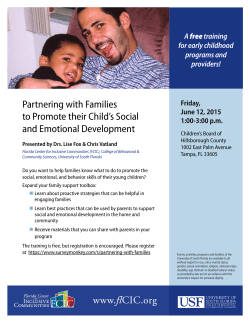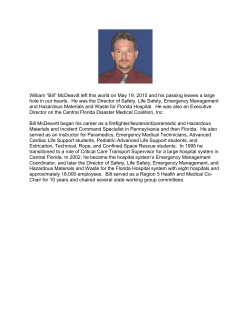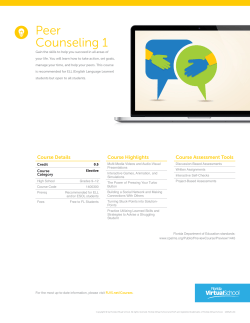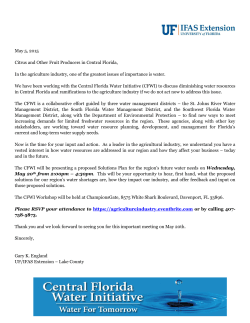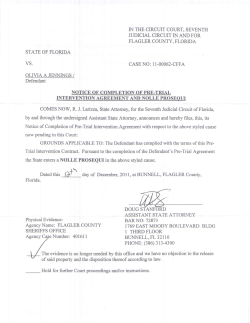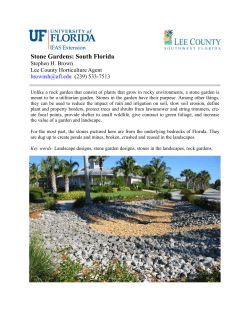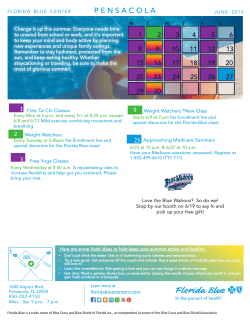
Extension Connextion - Miami-Dade County Extension Office
E tension Conne tion X Spring 2015 UF/IFAS Miami-Dade County Extension, 18710 SW 288th Street, Homestead, FL 33030-2309 http://miami-dade.ifas.ufl.edu 305-248-3311 Letter from the Editor INSIDE THIS ISSUE By Cassandra Weston-Hainsworth, 4-H Agent Greetings to all: Spring is almost here, and we are extremely Letter from the Editor 1 Native Invasive Species Awareness Week 2 National Nutrition Month 2015 3 Can We Grow Jalapeno Peppers Using Shade Cloth 4 Biscayne Bay Water Watch 6 programs that have been conducted by the Hands-On Activities with Branches 4-H Members 7 Extension office, as well as what we have on the Be on the Lookout: Argentine Tegus 8 horizon. Since the start of the year, we have already had several rain barrel workshops, a 4-H UF Environmental Horticulture Students Visit UF/IFAS Extension in Miami Dade County 9 4-K race, pesticide trainings, a food safety What’s New at Miami-Dade Extension 10 Contact Us 11 excited to share with you some of the amazing workshop, nutrition programs, and money management workshops, just to name a few. We are continuing to plan and develop new ways to reach the millions of people in Miami-Dade County. Last year, we celebrated 100 years of the Cooperative Extension Service. All across the country, programs were held to recognize the great accomplishments that have taken place over the years. 2015 marks the 125th anniversary of the 1890 universities, created by the Morrill Act of 1890, which established the Black Land-Grant Colleges and Universities in the United States. The official day of observance is April 23, 2015 and Dakshina Seal, and Bruce Shaffer on growing jalapeno peppers; Jake Edwards on Argentine Tegus; Lisa Krimsky on Biscayne Bay; Jeramy Smith on Branches 4-H Club; Monica Dawkins on National Nutrition Month; and of course, my co-editor Jeff Wasielewski. I hope this newsletter provides you with some valuable information and please take time to check out some of the great programs and events that will occur throughout the year. the theme of their year-long celebration is Yours in 4-H, “Providing Access and Enhancing Opportunities.” Cassandra For more information, please visit http:// www.1890universities.org/. We are very grateful to our colleagues who took the time to contribute to this newsletter: Vanessa Campoverde on invasive species and the UF Undergraduate Club of Environmental Horticulture; Wellington Araujo, Kati Migliaccio, . Program Spotlights National Invasive Species Awareness Week By Vanessa Campoverde, Commercial Agriculture & Ornamentals Agent During the last week of February, we celebrated National Invasive Species Awareness Week (NISAW), where several events across the nation Mediterranean fruit fly Citrus greening disease (Huanlongbing) Asian longhorned beetle Giant African Land Snail (GALS), originally found in Miami-Dade County! were conducted to raise awareness and identify solutions to invasive species issues at local, state, tribal, regional and national levels. If you would like to know more about this initiative, go to: http://www.nisaw.org What is an invasive pest? The U.S. Department of Agriculture defines an invasive pest as an organism that is introduced into an area beyond its natural range and becomes a pest in the new environment (also referred as: alien, non-native or introduced pests). The damage done by invasive plants alone costs the U.S. an estimated $34.7 billion a year. An invasive pest does not occur naturally in a specific area and therefore may not have any natural enemies resulting in no natural control and a strong chance for economic or environmental harm. How do invasive pests spread? There are a few ways pests enter the U.S. and are able to cross state lines: by "hitch-hiking" on vehicles, fruits, plants, seeds or animals when travelers enter the U.S. or travel within states. when travelers bring prohibited fruits, plants, seeds, animals or other items back from other states or foreign countries. What are some of the top invasive pest threats in the U.S.? about invasive pests? When pests affect our local agriculture or resources, then we all suffer from lack of local food sources and prices will rise, causing more damage to native species and to our home economy. Giant African Land Snails GALS were initially found only in Miami-Dade County, but since last year, they have been found in our neighbor Broward County. Invasive pests don’t know boundaries, so we always have to be on the lookout for them. More information and the map of the current GALS distribution can be found here: http://www.freshfromflorida.com/ Divisions-Offices/Plant-Industry/Pests-Diseases/ Giant-African-Land-Snail. This article was modified from information found here: http://www.hungrypests.com/ on shipments of plants, food and other materials If I don't work in agriculture, why should I care For more information visit your local University of Florida/ IFAS Extension office: http://miami- dade.ifas.ufl.edu/. Adult Giant African Land Snail (GALS) hanging out in a hedge. Can you spot it? The imported fire ant 2 National Nutrition Month® 2015 By Monica Dawkins, EFNEP Agent National Nutrition Month® is a nutrition education and information campaign celebrated annually in Recipe: Florida Flatbread with Tomatoes and Sweet Peppers March by the Academy of Nutrition and Dietetics. Initiated in 1973, “National Nutrition Week” was originally only a week, but became a month-long observance in 1980 in response to growing public interest in nutrition. The campaign focuses attention on the importance of making informed food choices and developing sound eating and physical activity habits. Each March and throughout the year, the Academy encourages everyone to return to the basics of healthy eating by adopting a healthy lifestyle focused on consuming fewer calories, making informed food choices and getting daily exercise. This year’s theme “Bite into a Healthy Lifestyle,” focuses on helping people create a healthy eating pattern and physical activity plan. By adopting these goals, this year’s theme strives to help people manage their weight successfully and reduce their risk of chronic disease while promoting general health. Your Own Private Nutrition Month Learning the facts about nutrition is a good step to celebrate National Nutrition Month and eat healthy all year long! Some reputable places to find nutrition information include: The USDA’s food guidance system: MyPlate.gov The Academy of Nutrition and Dietetics: EatRight.org Your local County Extension office: MiamiDade.ifas.ufl.edu Ingredients: 2 medium or 1 large baked flatbread or pizza crust 2 cups mozzarella cheese, shredded ¼ cup fresh basil, hand torn ½ cup Parmesan cheese, grated 5 cloves fresh garlic, minced 1 large Florida bell pepper (red, yellow, green or ⅓ of all 3 colors), seeded and sliced thin 2 medium Florida tomatoes, sliced thin 1 tablespoon olive oil sea salt and fresh ground pepper to taste Directions: Preheat oven to 375 degrees Spread olive oil and garlic evenly over the flatbread Evenly distribute three-fourths of the two cheeses over the flatbread Evenly distribute the bell pepper and tomato over the cheese Add remaining cheese to the top of the flatbread Season the flatbread lightly with salt and pepper Bake flatbread on a cookie sheet for 7 to 10 minutes until cheese is melted and bubbly Remove flatbread from oven and garnish with the hand torn basil Cut flatbread into several servings and serve warm 3 Can We Grow Jalapeno Peppers Better Using Shade Cloth? By Wellington Araujo, Kati Migliaccio, Dakshina Seal, & Bruce Schaffer Tropical Research and Education Center (TREC), UF Homestead, FL. The shade cloths being tested are Jalapeño hot peppers (Capsicum annuum), aluminet 50%, silver 30%, red 30%, pearl 30%, originating from Mexico, are popular due to their black 50% and control (without any cover). The nutrient content, pungency, flavor, color and aluminet 50%, silver 30%, red 30% and pearl 30% taste. They are a rich source of vitamin A, C, E, K are made by Polysack Plastic Industries. and other antioxidants that develop resistance against infectious agents. Burden (2012) reported that in the United States demand for jalapeño and other hot peppers increases every year as the popularity of ethnic cuisine increases. California and New Mexico produce most of the hot peppers grown in the United States, but many Florida farmers grow hot peppers as a niche crop (Ozores -Hampton and McAvoy, 2014). Trays with the jalapeño seedlings and plant in a pot with a tensiometer As world population continues to grow, resulting in less space for agriculture but greater food demands, we must try to increase the amount of food we can produce in a given space. One practice that might offer increased yield for a Cages in the field and four pots inside the Pearl cage at TREC given amount of area is the use of different shade cloths. Recently, colored shade cloth designed specifically for manipulating plant development and growth has became available. Stamps (2009) discussed the effect of this technique on the microclimate, vegetative growth, vegetative quality and fruit quality and yield. Plant response to different colors has been documented by Presented below are some preliminary data from this on-going study. Jalapeño plant growth was various authors for many crops (Bastias and The stem diameter of Corelli-Grappadelli, 2012); however the effects jalapeño pepper over are varied and plant responses may differ, even among cultivars of same crop species (Stamps, 2009). We are currently investigating application of five different shade cloths, as well as no cloth on time under different colors and shading (aluminet 50%, silver 30%, red 30%, pearl 30%, black 50% and controlwithout cover) measured at varying days after transplant (DAT) jalapeño peppers at the University of Florida, Tropical Research and Education Center (TREC) (Continued on page 5) 4 evaluated by the number of leaves, stem diameter and the leaf chlorophyll index (SPAD units determined with a SPAD meter). For all treatments, pepper production. Shade cloth can also be used with other horticulture crops. the number of leaves and stem diameter increased As for an answer to the question posed in the development. were shade cloth?, we aren’t sure yet! Stay tuned to However, a significant difference was observed on of shade cloth to grow plants and vegetables. where the control treatment (shade cloth) had Acknowledgements treatments. Stem diameter of the aluminet was the shade cloth, Ms. Tina Dispenza for project treatments on 46 days after treatment initiation assistance. over time, showing typical plant growth and No significant differences observed among treatments for leaf numbers. the last two stem diameter measurement dates, title: “Can we grow jalapeño peppers better using hear more about the idea of using different colors significantly less stem diameter than all shade The authors are grateful to Mr. Frank Giglia for significantly assistance, and Ms. Ana Vargas for equipment greater than that of the other (DAT). References Leaf chlorophyll index was significantly higher in Batias, R.M. and L. Corelli-Grappadelli. 2012. was significant lower than the others treatments. Physiological and technological aspects. Chilean chlorophyll index is affected by many factors, such Burden, D. and D. Huntrods. 2012. Bell and Chili stresses. Variations of this magnitude are not Center), Iowa State University. leaf turgor caused an increase in SPAD readings. vegetables/bell-and-chili-peppers the control group, while the Aluminet treatment Light quality management in fruit orchards: Martinez and Guiamet (2004) reported that leaf Journal of Agricultural Research 72(4): 574- 581. as leaf water content, irradiance and environmental Peppers. AgMRC (Agricultural Marketing resource unusual under field conditions and a decrease in http://www.agmrc.org/commodities__products/ Li, Y.C., W. Klassen, M. Lamberts and T. Olczyk. 2013. Pepper Production in Miami-Dade County, Florida. Serie HS859, Department of Horticultural Science, UF/IFAS Extension, University of Florida, Gainesville, Fla. Martınez, D. and J. Guiamet. 2004. Distortion of the SPAD 502 chlorophyll meter readings by changes in irradiance and leaf water status. Agronomie 24: 41-46 SPAD units for peppers at 60 DAT (days after transplant) under different colors and shading (aluminet 50%, silver 30%, red 30%, pearl 30%, black 50% and control) Ozores-Hampton, M. and G. McAvoy. 2014. Jalapeño and Other Hot Pepper Varieties for Florida. Results thus far suggest that the use of shade cloth Serie Horticultural HS1241, Science, Department UF/IFAS of Extension, increases plant stem diameter compared to no University of Florida, Gainesville, Fla. plant growth and yield data. Results will provide Stamps, R. 2009. Use of colored shade netting in shade cloth. The next step is to collect additional information on how shade cloth impacts jalapeño horticulture. HortScience 44(2): 239-241. 5 Biscayne Bay Water Watch By Dr. Lisa Krimsky, Sea Grant Agent As the Sea Grant marine extension agent, there 3. A phytoplankton bloom, consisting of two non are some perks to the job; one of them being the -toxic diatoms, occurred in the summer of drive to my office. Every day I get to drive over 2013 and persisted for two to three months. the Rickenbacker Causeway and enjoy the This bloom was the first of its kind as it did beautiful view of Biscayne Bay’s crystal blue not occur near shore, but in an open region of waters. Ask anyone who gets to spend time either the Bay. on or near the water, and I’m sure that they will share in that experience. Biscayne Bay is the lifeblood of Miami and visitations to and use of the Bay contributes significantly to our local economy. This is because compared to other Florida waters, Biscayne Bay is characterized by very low concentrations of nutrients and pollutants and has excellent water clarity. The clean water is responsible for the fantastic views and allowing recreational experiences such as fishing, diving and boating. While most people know that the Bay is protected either federally or by the state as a National Park, State Aquatic Preserve, or a State critical wildlife area, the majority of Biscayne Bay is also an Outstanding Florida Water (OFW). Although Biscayne Bay remains relatively healthy, natural and human-induced events can negatively impact the Bay’s water quality. During the past decade, three such events have occurred in Biscayne Bay. These events were: These algal bloom events, unprecedented in their scale or duration, resulted in impacts to over 10,000 acres of bay bottom. While the exact causes of these blooms remain unknown, they indicate a diminished ability by the Bay to handle occasional negative inputs. Biscayne Bay is suspected of nearing a “tipping point” for water quality and health. Map of the algal bloom areas by year Algal blooms are not new to the headlines. Algal blooms in the Great Lakes have been so extreme that they have impacted the availability of local drinking water. Locally, the Indian River Lagoon has suffered record numbers of dolphins and manatees mortality as a result of algal blooms. Luckily for us, the health and status of Biscayne Bay is not as critical as in other areas; however we 1. A phytoplankton bloom that started in 2005 need to heed these warning signs. Local support in south Biscayne Bay which persisted for and knowledge is critical for understanding how three years. changes to the Bay are impacting its long-term 2. A green macro-algal bloom initiated in 2008 health and economic and environmental viability. and continues (though diminished) today. The In response, the UF/IFAS Sea Grant extension impacted area runs along the western shore of program is developing Biscayne Bay Water Watch, central bay south of Rickenbacker Causeway to south of Coral Gables and out to mid-Bay. (Continued on page 7) 6 (Continued from page 6) educate the public and enhance the County’s a coalition of residents, groups and organizations efforts. Through the adoption of water monitoring who will be trained and jointly administer a stations within Biscayne Bay, partners will collect citizen science water quality monitoring program monthly water quality samples and data that will to be shared with Miami-Dade County’s Division of Environmental Resources Management (DERM) and the public alike. If you would like more information about Biscayne Bay Water Watch or how you or your organization can participate in please contact Lisa Krimsky at lkrimsky@ufl.edu or 305-421-4017. Visit https://www.flseagrant.org/wp-content/uploads/ Imperiled-Water-Quality-in-Biscayne-Bay.pdf for more information. Hands-on Activities with the Branches 4-H Members By Jeramy A. Smith, 4-H Agent One of the key objectives with UF/IFAS Extension 4-H members could 4-H Youth development programs is to give a kid construct their own a euphoric sense of accomplishment after insect. completing a “hands-on” 4-H project. This hands I am here to tell you -on objective was achieved a few weeks ago when that young people Brittany Harris, a Florida International University have creative minds. (FIU) graduate student, teamed up with me to do Many of the Branches a 4-H Enrichment Program at Branches 4-H members created afterschool program in Opa-locka, Florida. some wonderful Brittany and I came up with the consensus that insects. she would teach the science, and I would provide the fun activities for kids. We decided to teach the One of the kids came up to me to show me his kids entomology since the field was related to insect. Now, I must be honest that when the kid Brittany’s graduate work at FIU. came up to me, I had no idea on how to identify the blob of construction in his hands. He was On that particular day, we were teaching kids, disappointed because kids were picking on his ages 7 to 11 on the characteristics of insects. insect. I empathize for the young lad and I wanted Brittany shared with them that insects have to give him encouragement because he did put antennas, a head, thorax, abdomen, and six legs, time, effort and thought into his precious and I shared my favorite song called “Alfred the Caterpillar.” We passed out construction paper, pipe cleaners, bottle tops, and more, so that the (Continued on page 8) 7 (Continued from page 7) creation, so I used the knowledge that we learned from Brittany to reaffirm to him that his creation was indeed an insect. Our dialogue went somewhat like this: “Sonny, does your insect have antennas?” “Yes.” “Does it have a head?” “Yes.” “Does it have a Thorax?” development in 4-H is Mastery. People can tend to make the mistake that mastery equals perfection, but actually mastery is an on-going process that is a beginning to perfection. Zig Ziglar once stated, “You do not have to be great to start, but you have to start to be great.” In other words, mastery begins when young people put forth an effort to accomplish an objective. It may not be beautiful in the beginning, but with effort, passion, and encouragement, it can turn out magnificent. “Yes.” (Truthfully, I had a hard time identifying the thorax but the kid explained it to me beautifully.) “Does it have an abdomen?” “Yes!” “Six legs?” “Yes!” “Well, Sonny, then you created an insect!” The Branches 4-H member felt better. He walked away with a euphoric sense of accomplishment. I too felt great in giving the young man guidance and confidence in his creation. One of the four elements of positive youth I commend the youth development program at Branches in giving youth the opportunity to be great! These young ladies and gentlemen are brilliant and excited about learning. Their enthusiasm actually gets me pumped up about life and I am happy that Branches is a part of the UF/IFAS Miami-Dade County Extension 4-H Youth Development Family! Be on the Lookout: Argentine Tegus By Jake Edwards, Florida Fish and Wildlife Conservative Commission Wildlife Impact Management, Non Native Field Operations Argentine black and white tegus (Salvator merianae) are a species of lizard native to South America that have been introduced to Florida. Tegus are black and white in color with banding along the tail and can reach up to four feet in length. Tegu lizard populations are currently being assessed by the Florida Fish and Wildlife Commission (FWC) in several areas throughout the state through trapping and surveying projects. Thought to be separate introductions, Hillsborough counties. The Miami-Dade population is centered in the Florida City/ Homestead area. Wildlife officials are currently trying to gather more information about their populations in Miami-Dade County. Tegus are omnivores, eating both vegetation and other animals and show a special fondness for eggs. This raises concern with wildlife managers, there are two breeding populations in Florida; one in Miami Dade County and one in Polk and (Continued on page 9) 8 (Continued from page 8) as Florida is home to many imperiled species that animals. Most importantly, we ask people to be alongside gopher tortoises, American alligators, other exotic species is observed, please take a marsh bird species in their current range in decide how to respond. Reporting exotic species have been known to eat crops like tomato, to do so. FWC operates a hotline to report lay eggs. For example, tegus are found living our eyes and ears in the field. If a tegu or any American crocodiles, and a number of wading and photo. This will help us verify the species and Florida. In addition to consuming eggs, tegus is also quite easy and there are a number of ways berries, and bananas as well as palm seeds. exotics: 1-888-IVE-GOT1. You can also report These lizards are almost exclusively diurnal, “IVEGOT1” reporting app on a smartphone. sightings online at www.ivegot1.org or using the meaning they are active only during the daytime. They are often observed is along roadsides and grassy areas, and find refuge under artificial structures such as mobile homes, sheds, and Argentine Tegus observed near debris. It is recommended that homeowners seal Florida City (Liz up openings and holes in structures to exclude Barraco-FWC) these lizards. The general public plays an important role in assisting with research and management of these University of Florida (UF/IFAS) Environmental Horticulture Students Visit UF/IFAS Extension in Miami-Dade County By Vanessa Campoverde, Commercial Agriculture & Ornamentals Agent The University of Florida (UF/IFAS) Undergraduate Club of Environmental Horticulture students and their advisor Dr. Jim Barrett had a chance to visit two main education and research centers in South Florida: the University of Florida/IFAS Extension Miami-Dade County agricultural office and the UF/IFAS Tropical Research and Education Center (TREC), both located in Homestead. The undergraduate students from Gainesville spent all of their spring break traveling and visiting University of Florida/IFAS Extension and Research Centers across the state to learn about what UF/IFAS Extension agents do as they provide research based solutions to citizens at a personal and professional level. These students didn’t travel to the always sunny Miami-Dade County for fun, but instead traveled for an education and some insight on research and extension work. “We are very thrilled to share our unique jobs within the University of Florida Extension system to enthusiastic students”, said UF/IFAS Commercial Horticulture agent Vanessa Campoverde. Ms. Campoverde welcomed the students and shared with these future professionals the nature of what UF/IFAS Extension agents do in South Florida. Students learned about the economic impact of the agriculture industries including vegetables, tropical fruit and ornamental plants. They also learned about outreach community events, 9 (Continued from page 9) research and diagnostic work at the UF/IFAS Tropical Research Education Center (TREC), and collaborative work with many state specialists and organizations. If your organization would like to visit our locations, please contact us at 305-248-3311 or visit our website: http://miami-dade.ifas.ufl.edu/. What’s New at Miami-Dade Extension To use our Extension Calendar, please visit our website http://miami-dade.ifas.ufl.edu and scroll through the calendar. There, you will find all event information including how to register. 10 What is Cooperative Extension? The Cooperative Extension Service is the liaison between research conducted at the University of ADMINISTRATION: Teresa Olczyk, M.S. County Extension Director HORTICULTURE: Adrian Hunsberger, M.S. Urban Horticulture John McLaughlin, Ph.D Miami-Dade County. Our clientele includes growers (agricultural and horticultural), homeowners, youth, people interested in family issues or food and nutrition, and marine industries. Urban Horticulture Program Assistant The University of Florida/IFAS Miami-Dade County E. Vanessa Campoverde, M.S. of Florida's Institute of Food and Agricultural COMMERCIAL AGRICULTURE & LANDSCAPES: Commercial Ag/Ornamentals Henrique Mayer, M.S. Commercial Urban Horticulture Jeff Wasielewski, M.S. Commercial Tropical Fruit Qingren Wang, Ph.D. Commercial Vegetable & Pesticide Trainer FLORIDA YARDS & NEIGHBORHOODS (FYN): Jesus Lomeli Urban Conservation Unit Program Assistant Barbara McAdam FYN Program Assistant Laura Vasquez FYN Coordinator FAMILY & CONSUMER SCIENCE (FCS), FAMILY NUTRITION PROGRAMS (FNP) AND PROGRAM (EFNEP): EXPANDED FOOD & NUTRITION Sandra Canales, M.S. EFNEP/FNP Monica Dawkins, M.S. EFNEP Jacquelyn Gibson, M.S. FCS- Food, Nutrition & Family Finance 4-H: Florida and other universities and end users in Cassandra Weston Youth Development Jeramy A. Smith Youth Development SEA GRANT: Lisa Krimsky, Ph.D Sea Grant/Marine Extension receives direct funding from the University Sciences (IFAS) and Miami-Dade County’s Department of Regulatory and Economic Resources. The United States Department of Agriculture (USDA) is the third partner in this cooperative agreement. The Miami-Dade County offices are part of a nationwide system of information, outreach, and education offered by county governments and landgrant educational institutions in each state. Contact Us: ADMINISTRATION, COMMERCIAL AGRICULTURE , HORTICULTURE, AND FYN 18710 SW 288 Street th Homestead, FL 33030 Phone: 305-248-3311, Fax: 305-246-2932 FNP & EFNEP 300 East 1st Avenue, Suite 113 Hialeah, FL 33010 Phone: 786-391-0539 (Monica) 786-391-0540 (Sandra) 4-H & FCS 401 E. 65th Street Hialeah, FL 33013 Phone: 305-769-4050, Fax: 305-769-4052 SEA GRANT 4600 Rickenbacker Causeway Miami, FL 33149 Phone: 305-421-4017 Visit Us: http://miami-dade.ifas.ufl.edu The Institute of Food and Agricultural Sciences (IFAS) is an Equal Employment Opportunity – Affirmative Action Employer authorized to provide research, educational information and other services only to individuals and institutions that function without regard to race, color, sex, age, handicap or national origin.. U.S. DEPARTMENT OF AGRICULTURE, COOPERATIVE EXTENSION SERVICE, UNIVERSITY OF FLORIDA, IFAS, FLORIDA A. & M. UNIVERSITY COOPERATIVE EXTENSION PROGRAM AND BOARDS OF COUNTY COMMISSIONERS COOPERATING For sign language interpreters or materials in accessible format or other ADA Accommodations please call our office at least five days in advance
© Copyright 2025

